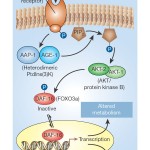Justin Williams ’13
Just today, April 18th, 2010, researchers from various universities (University of Pennsylvania School of Medicine, Tufts University, and The University of Illinois in Urbana-Champaign) published that they have developed a new and improved way to implant electrodes into the brain in order to monitor and react to different patterns of brain activity.
As of now, the most advanced methods we have for measuring brain activity are either thin needle-like electrodes that can be inserted deep within the brain or micro-electrode arrays (made up on dozens of electrodes attached to a silicon base or grid). Although both of these methods are useful, they each have drawbacks. The needle-like electrodes are very vulnerable and can be moved or broken when the brain changes position and the silicon base of the micro-electrode arrays do not allow for much flexibility when attaching to the surface of the brain.

However, now researcher Dr. Brian Litt M.D. from University of Pennsylvania School of Medicine and colleagues have developed a new and improved method that uses a silk base instead of silicon. Dr. Litt, when explaining their reasoning behind their micro-electrode array design, said that “the implants contain metal electrodes that are 500 microns thick, or about five times the thickness of a human hair. The absence of sharp electrodes and rigid surfaces should improve safety, with less damage to brain tissue. Also, the implants’ ability to mold to the brain’s surface could provide better stability; the brain sometimes shifts in the skull and the implant could move with it. Finally, by spreading across the brain, the implants have the potential to capture the activity of large networks of brain cells.” In addition to these advantages, the silk base can also be dissolved at a controlled time point which would provide for even better stability for the electrodes.
The potential impact of this new method for measuring and altering brain activity is enormous.This design has promising implications for treatment of epilepsy, spinal cord injuries, and other neurological disorders. For example, the arrays could be read the start of epileptic activity and deliver a shock that would calm the brain down and prevent the seizure. Although these results are a step in the right direction, researchers are still experimenting with varying numbers and arrangements of arrays in order to maximize the clarity of the measurements the electrodes read.
Sources:
http://www.eurekalert.org/pub_releases/2010-04/nion-abd041610.php
http://www.nature.com/nmat/journal/vaop/ncurrent/full/nmat2745.html
 By: Nicole Myers
By: Nicole Myers 

 Mar. 2010- Researchers at the Wistar Institute, a international leader in biomedical research, have discovered a gene that could regulate regeneration in mammals, bringing the possibility of re-growing amputated extremities one step closer to reality. The lab identified a gene called p21, that when turned off confers to mice the ability to regenerate lost tissue.
Mar. 2010- Researchers at the Wistar Institute, a international leader in biomedical research, have discovered a gene that could regulate regeneration in mammals, bringing the possibility of re-growing amputated extremities one step closer to reality. The lab identified a gene called p21, that when turned off confers to mice the ability to regenerate lost tissue.





